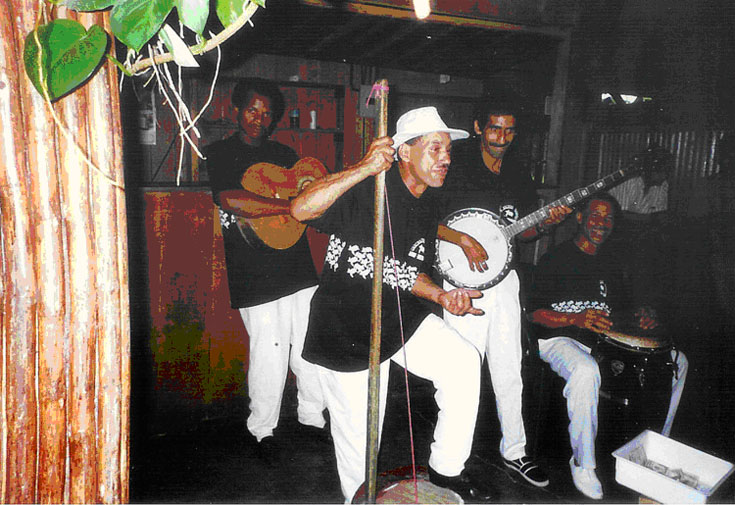|
|---|
Some Country Ticos Strike Up the Band... and a Uno and a Dos... |
Broken News
Expat Contest Results
In the mid-July supplemental issue our hero bloviated about his displeasure regarding the term "ex-pat" or expatriot, a citizen of one country living in another as a guest resident. Being incapable of coming up with an alternative description myself, I suggested that our Gentle Readers could enter a GGC contest and make their own suggestions by emailing me. Contest winner would get lunch.
The deafening silence that followed was either an indication of confoundedness on the subject similar to my own or a profound disinterest in the topic. My guess is it was the latter. However there were a few brave souls who offered the following:
- One smart (I use the term in its unhyphenated short form) attorney friend had this to offer: "On that I stand Pat and given your recent experience with Residencia Ex-pediters, perhaps an appropriate new name would be "Patsies" (to see what he's referring to, go here: Gullible Travels)
- "Black Sheep" Simple and to the point.
- "Protraho ut exemplar" or "defer to original". There's always an intellectual in the crowd ready to impress us with his Latin. Maybe "exempat", hmmmm.
I don't think we've hit the essence of the animal yet but, not being able to choose from the above (one of my strengths is procrastination), GG offers lunch to all three when they're next in town.
¡Pura Vida! or is it ¡Pura Patria!
Classy Rescue
Let's suppose you're a fishing boat returning from a visit to the Cocos Islands and your engine dies. For some reason the radio also doesn't work, is weak or maybe is beyond range.
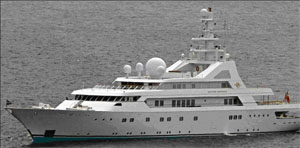 |
|---|
The Golden Odyssey Rescue Vessel |
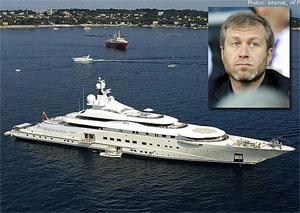 |
Roman Abramovich & His Skiff the 'Eclipse') |
Now, you have to go some 550 km (340 miles) to find land at Quepos to the East/Northeast. So you drift, God knows where, for 8 days. This is what happened to the 30 foot ‘Maria Christina’ recently. Other than pray, what do you do?
Get rescued by a 266 foot luxury yacht, of course. The Golden Odyssey (left - top) came to the rescue towing the Maria to port as well as caring for the survivors. Much better fate than being picked up by a smelly old shrimp trawler, although I bet the survivors would have been happy to see a stinker also.
I was curious if a 266 foot yacht was one of the biggest in the world and who owns it. Turns out the Golden Odyssey is a piker in the mega yacht category, ranking only #67 in the top 100. It's owned by an arab royal as are seven of the top ten super yachts around the world (nothing like that oil money, bin amigo).
Many of the world's mega yachts were built at the Blohm & Voss Shipyards in Hamburg, Germany including seven of the top ten. The Golden Odyssey was built there in 1990.
But the grand prize for being ostentatious afloat goes to a dude named Roman Abramovich, a 45 year old Russian. His boat, the Eclipse (left), comes in at 162.5 meters (533 feet), two feet longer than the #2 ranked yacht, the Dubai (you don't need to wonder where that name came from or who owns it). The Dubai was ranked #1 in 2010 but Roman wasn't about to let an arab get the better of him. And where did Roman get all his rubles? Why from oil of course, good Russian oil, da.
I spent four days on an 80 foot Hatteras once traversing from the waters of the west coast of Florida across Lake Okeechobee and up to North Carolina. I thought that yacht wonderful and the trip invigorating, including a brief encounter with a U.S. nuclear submarine (just popped up one morning). I wonder what the chance is of being cast adrift on something like the Eclipse for eight days? I'm open to that kind of marine hardship, amigos.
Я должен быть столь повезло. (Russian for 'I should be so lucky')
Huelga at ICE
A few weeks ago I found myself in San José once more on some miscellaneous personal business. Going to San José to do or get things one cannot do or get in Quepos has become rather routine for our hero.
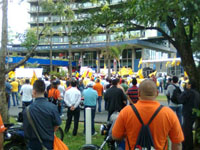 |
|---|
Strikers Exhorting the Crowd Outside ICE Headquarters |
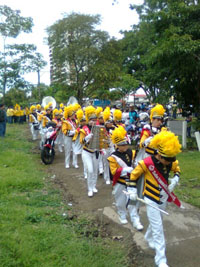 |
Every Strike Needs a Band |
I had stayed in Heredia overnight and the business I had was to help a Tico friend try to get some information on obtaining a U.S. tourist visa. We intended to do so at the U.S. Embassy in Pavas, about 10 miles east of Heredia. As it turned out, engaging a human being to answer a few questions about visas is nearly an impossibility in the internet age (more below).
Thinking myself quite clever these days at traversing the environs.of "Chepe" (another nickname for San José - see What's-in-a-Word below), GG figured two buses would be necessary, one from Heredia to the Crown Plaza Hotel near La Sabana park and then a short walk to another bus along the north side of the park which would take us the two or three miles into Pavas and drop us very close to the embassy.
What was that about the best laid plans of mice and men? Bus trip #1 went as planned but as we approached the corner of the park we noticed that the street was blocked and no bus or any other vehicle could get through. Now this is a major route through a large and busy part of San José and it takes something major to shut it down.
We could hear cheering and a squawking loudspeaker coming from some distance down the street in the direction of Pavas and we walked towards it. The street was filled with demonstrators in bright yellow and orange shirts with "ICE" printed on them. (No, Dorothy, this is not the Immigration and Customs Enforcement bureau; here it's better known as the electric company)
On the way we asked one of the yellow shirts what was going on and he said it's a "huelga" or strike by ICE workers. ICE (pronounced ee-say) is the Instituto Costaricense de Electricidad and in the beginning they were a monopoly created and owned by the government, charged with generation, transmission and distribution of electricity. They were responsible for and owned the whole schmere.
Over the years the government has slowly been privatizing phases of this process. Now, only the transmission step is wholly controlled by ICE and there is a bill currently progressing through the Assemblea which would complete the transition process by privatizing the transmission phase also. The public employees unions of course are against it, hence the huelga.
Also, over the years ICE picked up telephone, TV cable and internet products and services as the telecom industry matured. In recent years, however, the government has opened these markets to private concerns for all these services as well. Methinks competition will eventually bring better service; one can only hope so.
A couple of years ago I made a bet with a friend that if, in any one week all utility services (electricity, telephone, cable, internet and water) worked without interruption, I would buy him lunch. As of this writing I have not lost the bet.
Secretly though, what I really want is one of those bright yellow ICE t-shirts.
Soy Tico
(A Feeble Attempt at Capturing the Psyche of My Host People)
When I think of the United States I think of freedom, entrepreneurialism, efficiency and innovation. It's ingrained in the gringo psyche by over two centuries of practice. How can we make something different, faster, better, cheaper? There is no other place in the world that's as good at doing that than is the U.S. of A.
So how does one similarly describe being Tico, how can the essence of being Costa Rican be captured in words? I must admit I can do it only with some difficulty and it's probably because the Tico character is more subtle and tilted to the romantic side of the brain (right) and I'm a hopeless technoboob (left sided). I freely admit I have no training in psychology but a lack of credentials has never stopped me from bloviating on disparate topics before and I don't see why it should now.
Here are some of GG's perceptions derived from observations on the essential nature of Ticos after living in Tiquicia for four years (Tiquicia is another, warmer synonym for Costa Rica - see What's-in-a-Word below) :
The Negatives
First of all. let's get the negatives out of the way. No culture, of course, avoids having some weaknesses or negatives. Here are the ones perceived by GG and others.
In Costa Rica, gringos accustomed to U.S. ways of doing things often get frustrated, and rightly so, with the lack of efficiency in Ticoland. Getting routine things done or dealing with the government sometimes requires inordinate amounts of time, money and paperwork. International third party business rating services confirm this (see World Bank Index). Oh yeah, things get done, eventually, but that drive for efficiency just isn't there.
On a more personal basis there are two things that most outsiders find irking.
One is the way many Ticos have no concept of personal space. That means they're likely to walk right in front of you, even cut you off without offering any excuse or apology. This treatment is not exclusively applied to gringos, Ticos do it to each other as well. I guess we can call this a cultural difference. They rarely hold doors for anyone and even more rarely thank you for holding one for them. They'll sit or stand next to you on a bus or in a public area and constantly brush up against you, never acknowledging you're there or realize they're doing it. The other side of this curious (to a gringo) way of doing things is that almost all Ticos will defer and quickly give way to 1) a pregnant woman, 2) a woman with a small child, 3) a very old man (GG hasn't gotten there quite yet), in that order.
 |
|---|
Tico Standard Time |
The second weakness is legend. All things are done in Tico time, meaning longer and later than you think or expect. A classic example of this for me is at the indoor soccer arena (futsal), where I've never seen a game start on time. The neighborhood games are scheduled in the evening at 6, 7, 8 and 9 PM. Since each game is an hour and often all four time slots are taken, that kind of scheduling is bound to create delays. There's no suggestion that the game quit at five minutes before the hour to allow the new game proper access. But even if there's no game before 6, the game is likely to start at 6:10, minimum, because the players all show up late. That means the seven o'clock game will actually start at 7:15 or 7:20 and the game at eight even later so that the niner is unlikely to get going before 9:30. Pura vida!
But, on the positive side, here's the way I see Tico culture:
A Tico/Tica is always ready to help if you ask politely. They are always ready to engage in a conversation, language barrier notwithstanding, on any topic you'd like to bring up and they love to throw out a quip or non sequitur to enliven the conversation or make you feel comfortable. They are social animals, love celebrations, and have an almost continuous parade of fiestas all over the country for many different causes and reasons.
 |
|---|
A Smiling Tica |
Costa Ricans are basically very friendly and happy people, which might be why Costa Rica topped the world ranking in the latest Happy Planet Index. This index blends subjective measures of "experienced well being" obtained from personal interview samplings of the populace, with an estimation of the use of resources per capita in the country. (Note: some think this index is flawed as it leaves plenty of room for creative assessment because of the subjective nature of both measurements).
Ticos love to smile. I've made comments periodically to a few gringo friends that Costa Ricans have some of the best smiles in the world and when they use them, one immediately feels comfortable and attracted. Each time I've mentioned this, my gringo friends have agreed wholeheartedly. This characteristic is particularly true with younger tico children who can melt your heart with a simple flash of their smile.
Gentleness
Ticos are gentle people and avoid confrontation. Yelling at someone in anger in public can be even be grounds for arrest as it's written into the law. But you just don't see it happen here, except perhaps with the occasional borracho (drunk). But the absence of confrontation and loud argument is not because it's repressed by law. It's more because the basic nature of Ticos is, quite simply, gentle.
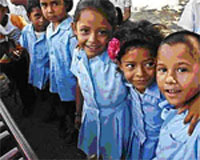 |
|---|
Tico School Kids |
And they treat their kids gently also. I can't think of but one instance in four years of living here when I've seen a tico dad or tica mom physically discipline a child by strongly shaking or spanking them. On the contrary, I suppose the adults might be criticized for sometimes letting their kids run a little wild, like at the futsal on Thursday night when the moms are playing and the little kids are running higgely-piggely back and forth on the bleachers. Of course I always made the same criticism about irritating little kids in the States. Nonetheless, despite, or perhaps because of the gentle treatment, the kids here seem to grow into well disciplined gentle adults.
And Ticos are affectionate to their kids. Lots of hugging and kissing goes on, particularly with the smaller ones. Tico families spend a fair amount of their meager income on toys and trinkets for their kids. They spend an even larger amount on kids clothes and when the kids go to school in the morning, their uniforms are clean, pressed and crisp.. Even outside school, the kids are always in clean and in bright clothes. That's significant because clothes here are fairly expensive given that many of these products must be imported and especially in light of the relatively low wages earned by the average Tico, (the Stats say Tico income per capita is one seventh that of the U.S.).
Romanticism
Latin culture, Costa Rica being no exception, is deeply rooted in the romantic side of human nature. This is, of course, well expressed in their literature, art and music. I have discovered legends here that are purely wistful and full of imagery. Take, for example, the Legend of Zurqui.
In this legend, which is based on the early indigenous people of the central mountains, a Romeo and Juliet like relationship forms between two youngsters of different tribes that are enemies. The lovers flee but are chased into the mountains by elders of one family until the prince is killed by an angry mob of pursuers. The princess and her friends continue to flee but, magically, they slowly turn into beautiful butterflies and are joined by the prince, escaping their pursuers and giving a possible explanation of how the incredible variety of butterflies came to be prolific in Costa Rica (like the Morpho). A nicer ending than Romeo and Juliette.
In music, their songs include whimsical, yet positive stuff like "¡Ojalá!" which is a bouncy country tune by someone wishing to see a bountiful harvest. He sings: "¡Ojalá! que llueva café en el campo, que caigo un aguacero de juca y té" or "I hope that it rains coffee in the countryside and there's a rain shower of yuca and tea".
Or how about this well known song of a lover lamenting his/her one brief love experience:
"Solamente una vez
amé en la vida
solamente una vez
y nada más
Una vez, nada más
en mi huerto brilló la esperanza
la esperanza que alumbra
el camino de mi soledad"
Loosely translated (English translations don't seem to do the poetry and imagery of many Spanish lyrics justice): "Only one time, for me (only one time) in my life, only one time, and no more. One time, no more, in my garden a ray of hope, hope that lit up the path of my solitude".You can also find a translation for this called "You Belong to My heart" which somehow loses the romantic force of the original lyrics (but the new words fit the music and try to parallel the sentiment).
Ticos see themselves in a direct connection with the land and its soil. Take, for example, the lyrics from the national anthem:
"Hail, O homeland! Your prodigal soil
Sweet shelter and sustenance gives us.
Under the unsullied blue of your sky,
May peace and labor ever live!"
"Soy Tico" ("I Am Tico" - 4 mins) |
And, as another example, consider some lyrics taken from a song called "Soy Tico" (I Am Tico - the song in it's entirety can be played via the video on the left):
'...y cuando caen los fuertes aguaceros
es como si yo fuera la semilla
me huele a tierra fértil el sendero
llenando de ilusión mi alma sencilla" OR
and when the heavy rains fall
it's like I were the seed (and grow - Ed.)
the trail smells of fertile earth
filling my humble soul with illusions (daydreams)
So, in summary, even with the differences and apparent deficiencies mentioned above, the basic character of the Tico is friendly, gentile, romantic and greatly outweighs the negatives.
The Tico experience is all summed up in their tag line, which is used prolifically and which is also their philosophy of life: ¡Pura Vida!
GG wishes my Tico friends¡Sólo Bueno, amigos, only good!
POPS
(Galactic Treats)
One time, long, long ago, in a galaxy far, far away, I was making my first visit to the planet called Earth. I parked my interstellar spacecraft near the moon and was beamed down to a very green country called Costa Rica and to the central square of it's biggest city. I began exploring La Plaza de la Cultura (translated from the original Vulcan, this means Culture Plaza - but you figured that out, didn't you).
It was a warm and beautiful day and as I watched young children feeding and chasing space-pigeons across the square, I noticed a small, but busy shop on one corner of the plaza. Eventually I wandered over taking note of the "POPS" sign above the door. "I wonder who Pop is or was", mused our hero?
 |
|---|
When You See This - Stop! |
 |
Try Some Orange Crush? |
The Force was with me. Inside was an ice cream (helado) bar where several clerks were processing orders for cones, sundaes, splits and shakes. Despite the staff dispensing orders at a good clip, the customer waiting line was at least ten people deep. I immediately took my place in the queue in hopeful anticipation of some new kind of experience. I was not disappointed and I've been back to this store, and several of its sister stores, dozens of times since.
Waiting in line at POPS over the years since then I have witnessed the curious process that the staff goes through of weighing each cone, yet I have never seen an adjustment made to an order after weighing. Either the staff is trained to instinctively measure in perfect units or the procedure is only perfunctory. At 1,500 colones or $3 for a modestly sized double cone, the super precision displayed by this exercise would seem unnecessary; but as a business consultant I have to admire the attention paid to portion quality control.
I quickly became addicted to POPS' chocoalamendras flavor (chocolate almond). Combine it with a scoop of their delicious pistachio and it becomes a virtual inter-galactic spiritual experience. I am now totally unable to pass that particular store when I'm in San José. It's as if I'm in the grip of a powerful Xylon tractor beam.
Turns out POPS is an all-Costa Rican owned company (it is officially and corporately known as American Ice Cream, S.A.) that was founded over 40 years ago on the premise of offering a superior ice cream product to Costa Ricans. You succeeded, amigos. I'm told the name POPS has no relation to the founder or anyone else and the original idea of why it was used has faded.
Their rich product is on the level of Häagen-Dazs and Ben & Jerry's. Oh yeah, POPS is higher fat than most commercial brands, so resign yourself and put away your BMI calculators. POPS does not offer all the decadent combinations of fruit, nuts, chocolate chunks, etc. that B&J does and both B&J and H-D might be slightly higher in fat, but in this space cadet's opinion, the richness of POPS helado is indisputable (and I've sampled stuff from all over the galaxy and beyond).
At one point last year, in a flash of hopeful anxiety, I decided to contact POPS HQ in San José and suggest (beg for) a new store in Quepos. Jacó has one - nyah, nyah, nyah, nyah. First I consulted a couple of our local business development gurus and one informed me that they had made contact with the company a couple of years prior and that POPS had already taken a look at our market and decided it was not yet ready for one of their stores. OMG, amigos, stab me in the heart why don't you, stun me with your Phaser as I weep for that decision. Maybe next year they'll relent or maybe we can talk them into a mind-meld.
Future Flash Forward! Not much more than a year after I contacted them and was turned down, POPS relented and opened a store in Quepos - see the announcement HERE. The mind-meld worked.
 |
|---|
| Could This Be POPS CEO Carlos Abreu? |
POPS has recently announced that they now have a presence in four countries. They have also opened their first stores in the U.S. (South Florida, West Coast). They also are the Costa Rican distributor for Häagen-Dazs. POPS CEO Carlos Abreu says "It’s clear that POPS is one thing and Häagen-Dazs is another.” Maybe to you amigo but the difference is a little hazy to me. I guess I must resign myself to continue taste testing both brands to arrive at some discernment between them.
POPS is also distributor for a number of General Mills product lines. In addition they are now opening sandwich shops called Entrepans. The company is expanding rapidly throughout the central and north galactic quadrants. But to the POPS executives I say, mis amigos, please don't forget your original strength. Ice cream is your core competency and my particular pleasure.
You have a product that is out of this world, so grow, my amigos, live long and prosper and may the Force be with you!
Beam me up Scotty.
GG out.
Medical Tourism
(Fix It and Flaunt It)
One of the things that is still relatively inexpensive here compared to the United States is the availability of quality services such as minor surgery, cosmetic surgery and dentistry. We're talking about the private health care system here, not the public socialized side, which is not available to non-residents. Both systems operate separately but in parallel here.
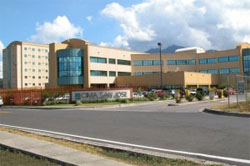 |
|---|
San Jose's CIMA Hospital |
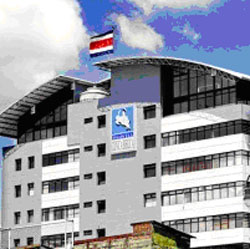 |
Hospital Clinica Biblica |
Say Pura Vida! |
People who visit Costa Rica expressly to avail themselves of these services are said to be participating in "medical tourism". Come and fish, go to the beach or do some ziplining and, on the way in or out of the country, get a varicose vein repaired, a tummy tuck, a hernia repaired or a new dental bridge.
There are several private hospitals in Costa Rica. Probably the best known are Hospital CIMA and Clinica Biblica. Because it calls itself a "clinica" doesn't mean it offers limited service. Clinica Biblica for example is a full service hospital. CIMA in particular caters to the needs of Americans and states so on it's English web site at (http://www.cimahospital.com/)
CIMA is a relatively new hospital having been constructed in the year 2000. Clinica Biblica, although in a new building, was formed in the 1920's by several missionaries coming from Scotland, Ireland and a number of latin countries.
The healthcare offered at these institutions usually gets high marks for quality of care and service. The two hospitals pictured to the left are fully accredited by international organizations including the Joint International Commission (JCI). Johns Hopkins requires this rating for all of their foreign affiliates. Costa Rica can boast that it is the only country on the world list where all the private hospitals in the country are JCI accredited.
Reports are that the cost of many procedures here is one half to one third the cost of the same procedure in the U.S. The reason for this is probably just the difference in wages and salaries - the income per capita in Costa Rica is one seventh that of the U.S. Therefore, cost of services that have a high labor content, such as medical, end up costing less where labor costs are less. (Note: This does not hold for products sold here because many are imported and reflect high import tariffs)
GG has had two experiences with the private medical system here. After a couple of months in Costa Rica, I developed a case of congestive heart failure and was referred to a doctor by a gringo friend here.See Por La Salud. I'm sure the problem had nothing to do with 45 years of cigarette and cigar smoking (yeah, right). Of course that had to finally cease.
 |
|---|
Say Ah - Pura Vida! |
The doctor turned out conveniently to be located only a block and a half from where I live in Quepos and, even more importantly, he turned out to be good. He quickly confirmed his suspicions with an x-ray and started me on medications which had me feeling better in a short time. Also conveniently, maybe even providentially, old Doc Mojarro was assigned to me when I joined the national health system some time later. I now see him every four months in the Caja (national health care system) for a check up and to get my prescriptions renewed.
The second experience was only a few months ago with a dentist, a cool Tico dude named Alberto Gonzales. Al is a tall, thin, young guy with a Tico smile (that's not him in the photo). I thought I was going to hate him on the basis of those facts alone but he turned out to be too friendly to not like. I only went to see him because I had broken a front tooth and was looking a little like a nervous vampire.
So, I needed a crown and he offered me either a veneer made out of a UV-setting acrylic which would last some years ($50) or a porcelain dude ($300) which would last indefinitely. I know the porcelain type as I already have a couple of them that were installed back in the 1970's - they didn't wear out but they did discolor. Alberto said (he speaks great English) that "the acrylic won't last forever like the porcelain but certainly a good number of years". I said "Give me the acrylic, I'm not going to last forever either". Hell, at 50 bucks a pop, you could have the damn things redone every year if you had to. His procedure involved no pain whatsoever and a half hour later I had my acrylic cap.
I've been so pleased with the results that I've been back to Al two more times for additional acrylic veneers. I have a fourth tooth targeted and after that I expect to have the best smile I've had in decades (at least a 7 rating on the Tico smilometer).
Four teeth for $200; que bueno, amigos. (update note: Alberto's price of a cap is now up to $60 as of December 2015; his technical competence remains impeccable)
What's-in-a-Word
Tiquicia (Te - kee- sha)
This is a term "mas cariñosa" (more loving) than say Ticoland or simply Costa Rica. It applies to anything and everything related to Costa Rica and can be used as both a noun (the country) or an adjective such as musica tiquicia or Costa Rican music. (What, you expected something more profound?)
Chepe (Cheh - pay)
Basically "Chepe" is a nickname for José. José is to Chepe like Joseph is to Joe or Joey or Robert is to Bob. The reports recently noted that a Salvadoran drug kingpin had been arrested. They referred to "Chepe Luna" being incarcerated. This particular Chepe, however, is a chico malo (bad boy).
Chepe is also a nickname for San José so someone from SJ is said to be from Chepe. It seems to be a bit molder to call someone a Chepe meaning he comes from the central valley than it is to call them a comohuevo.
ROMEO Corner
(Retired Old Men Eating Out)
Raphael's Terraza
Location: On Manuel Antonio road just down from La Cantina restaurant and next to the
Hotel Arboleda.
Hours: Daily: Breakfast, Lunch and Dinner.
Parking: Ample on site at the restaurant.
Contact: Tel.: 2777-6310; Email: raphaelsterraza@gmail.com
Reviewing ROMEOS: David H., Laura C., Rhett B., Roberta W., John S., Bob N.
To Review Our Rating System and Procedure, go here: R.O.M.E.O. Rating System
I had been to Raphael's twice for lunch but never for dinner. We definitely have missed a treat up until now.
The restaurant is located on a rocky outcrop about half way down the south side of Manuel Antonio road. The easiest landmark in this area of no street names and no addresses is to remember it's right next door to the Arboleda Hotel. We arrived just before dusk in time to catch the magnificent view directly overlooking Elephant Island just off Manuel Antonio beach. The dining room panorama also includes a direct view of the sunset.
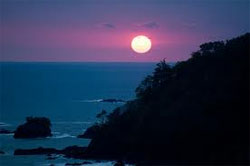 |
|---|
Dining Room Vista at Sunset |
The front walls of the dining room are open to the atmosphere and the room receives gentle breezes from the Pacific. Of course, like all restaurants here, one needs to eat dinner early (before 6 PM) to catch the sunset. For lunch In the light of day there's a view of the Pacific, small islands and a the green jungle below.
The dining room is plain, in traditional Tico style. The lighting is low which makes for a soft atmosphere but, like many restaurants here it also results in the usual difficulty in reading menus and checks printed with almost no ink. Why are Ticos so stingy about ink in their printers?. (Of course it has nothing to do with the writer's developing cataract problem, I'm sure)
We were pleased to learn our service was to be primarily from the owner, Raphael who also turned out to be a neighbor of GG's living in Barrio Los Angeles in Quepos. He gave us a lot of personal attention throughout the evening. He even delivered a plate of chimichurri and guacamole with chips to our table as a gesture of friendship. We ordered a second plate because it was so good.
Selections for entrees varied among our group of six and included grilled tuna steaks, a filet of beef, a pasta plate and dinner salads. The tuna steaks were outstanding, at least 1 1/2 inches thick. In fact I thought Raphael had confused my tuna steak with the beef filet - he quickly reassured me it was the right order. My tuna, done beautifully rare as ordered was mounted on a pile consisting of a roasted half potato. a fried plantain and some julienne carrots. The mound was drenched in a light asin sauce. Yummers. One ROMEO reported the filet of beef to be tender and tasty (tender beef is not always found in this vicinity) and the other ROMEOS reported their meals to be fresh and tasty. |
 |
|---|---|
$$$$ |
The desert selection was a bit limited but the chocolate cake with a very creamy. mocha-like frosting and a dollop of rich vanilla ice cream sufficed.
Since we had four new participating ROMEOS, GG reviewed our R.O.M.E.O. Rating System at the table (management can never sleep, amigos). A poll of the six present resulted in an average sloth rating of around 4.7 so we gave Raphael's a top rating of 5 sloths overall for ambiance, food quality and service.
My bill for the appetizer, tuna steak entree, the chocolate cake with ice cream and a soft beverage was about 15,000 colones ($30). This puts Raphael's a bit below the most expensive restaurants in the area so we gave the restaurant a cost rating of four dollars out of a maximum of five possible.
The ROMEOS can easily recommend Raphael's Terraza as a great option for dining in Manuel Antonio.
Founder's Quotes
"The powers delegated by the proposed Constitution to the federal government are few and defined. Those which are to remain in the State governments are numerous and indefinite."
-- James Madison, Federalist No. 45
don Beto de Quepos, El Gringo Dorado Pura Vida! |
Be pithy but kind. I'm sensitive. |
|---|

